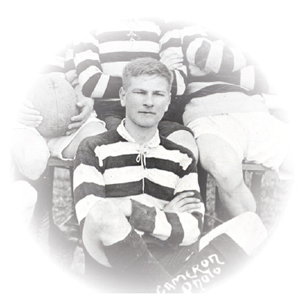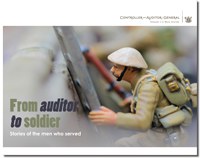Clarence Dornford Thompson
 Nelson man Clarence Dornford Thompson joined the Audit Department in April 1907. At the outbreak of WW1, he had attained the position of Audit Examiner, Class VII. He had passed the Senior Civil Service Examination.
Nelson man Clarence Dornford Thompson joined the Audit Department in April 1907. At the outbreak of WW1, he had attained the position of Audit Examiner, Class VII. He had passed the Senior Civil Service Examination.
In August 1914, aged 24, Clarence joined the New Zealand Expeditionary Force (Medical Corps). He went to Samoa that month as part of the Samoan Advance Party, which was sent by the New Zealand Government to force Germany out of Samoa.
The 1385-strong Samoan Advance Party sailed from Wellington on 15 August 1914 on two passenger ships (the Moeraki and Monowai).
The Samoan Advance Party landed at Apia on 29 August 1914 and met with no resistance. The German defences comprised 20 troops and special constables.
In July 1915, Clarence was sent to Egypt. He served at the New Zealand Stationary Hospital at Port Said, a 500-bed convalescent hospital that was set up under canvas.
The hospital had been in place for about three months when orders were received for the Medical Corps to proceed to “a certain destination near the sea and with a mild, equitable climate”.
The destination was the Greek port city of Salonica (Thessaloniki). The hospital was loaded on to a train for Alexandria, Egypt’s second city, and then on to the ship Marquette. The Marquette was a troop carrier, transporting 500 soldiers and ammunition. With the crew included, there were more than 700 people aboard. The ship sailed from Alexandria on 19 October 1915.
On the morning of 29 October, when the Marquette had almost reached Salonica, some New Zealand nurses were walking on the upper deck of the ship. One of the nurses saw a green line flashing through the water and said to her friend: “I wonder if that is a torpedo?”
It was – a German submarine had attacked the Marquette. The torpedo hit the ship, which sank in little more than 10 minutes, killing 167 people. Among the dead were 10 New Zealand nurses and 22 other staff from the Medical Corps, including Clarence, whose body was never recovered. His name is recorded on a memorial in the Mikra British Cemetery near Salonica, which commemorates more than 500 people who died in the Mediterranean and whose bodies were never recovered.
The British hospital ship the Grantully Castle left Alexandria for Salonica on the same day as the Marquette. There would have been ample room on the Grantully Castle for the Medical Corps. Many of the survivors of the Marquette were treated on the Grantully Castle, which had already arrived at Salonica.
After the sinking of the Marquette, all hospital units travelling by sea were required to use a hospital ship (under the Geneva Convention laws of war, hospital ships are protected from attack).

